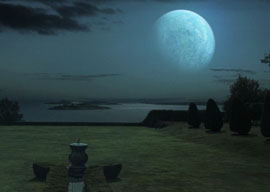
June 06, 2012

Melancholia‘s prologue is the rare art film to notice the almost alien beauty of an imaginatively lit golf course. Von Trier cites the sand-trapped last scene of Michelangelo Antonioni’s La Notte to legitimize filming much of Melancholia on a golf course, but that’s just a precedent for the film-school pedants. The tree-lined Swedish course in Melancholia isn”t even a terribly good golf course, but it still looks like a great place for the Last Days. As von Trier notes:
There’s something oddly melancholy about golf courses. They go on forever and, if you take away all the golfers”and you won’t find a single one here”they’re amazingly cultivated landscapes.
The ancient Greeks believed that each planet in the solar system emitted its own resonance, creating the harmony of the spheres. For example, Plato assumed the entanglement of astronomy and music in The Republic:
…the eyes are designed to look up at the stars, so are the ears to hear harmonious motions; and these are sister sciences”as the Pythagoreans say….
The Greek notion that the planets are embedded in crystalline orbs, revolving to serene celestial harmonies (just as 2001‘s space station rotates to Johann Strauss Jr.’s Blue Danube waltz), afforded humans a reassuringly static celestial model, a dance to the music of time with no conceptual room for Melancholia‘s unmoored killer planet.
This mystical-scientific view continued at least through German astrologer-physicist Johannes Kepler’s 1619 book The Harmony of the World. This perspective remains highly influential in the arts, such as Gustav Holst’s popular orchestral suite The Planets and C. S. Lewis’s Narnia fantasy series.
For most of human history, artists and philosophers saw their role as guardians and embellishers of order, purveyors of the past, and keepers of the classics. By the Romantic 19th century, however, European civilization had achieved enough stability that some artists became advocates of permanent cultural revolution.
After the crushing of the 1848 revolution in Germany, Wagner gave up his socialist activism in favor of composing an opera about the overthrow of the ruling class, the end of the world, the Götterdämmerung. Wagner’s revolutionary impulses became focused upon the aesthetic, upon undermining the Western sense of stable tonality.
As with most things Wagnerian, this new opera (or, as it turned out, four operas: The Ring of the Nibelung) wound up taking a long time. To raise cash in the meantime, Wagner decided to write what he initially intended as a commercial work, Tristan und Isolde. This wound up finally debuting in 1865 to puzzlement, followed eventually by acclaim as the mid-19th century’s most influential artwork.
In 20th-century composer Arnold Schoenberg’s description, Wagner’s chord progressions in Tristan sound much like the rogue planet Melancholia, always “roaming, homeless, among the spheres of keys.”